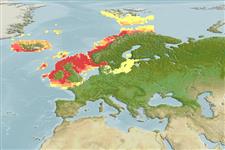Classificação / Names
Common names from other countries
Referência principal
Tamanho / Peso / Idade
Max length : 35.0 cm TL macho/indeterminado; (Ref. 1371); common length : 19.0 cm TL macho/indeterminado; (Ref. 4645); Idade máx. registada: 5 anos (Ref. 273)
Length at first maturity
Lm ?, range 11 - 15 cm
Ambiente
; marinhas bentopelágico; oceanódromo (Ref. 51243); intervalo de profundidade 50 - 300 m (Ref. 54932), usually 100 - 200 m (Ref. 54932)
Clima / Intervalo
Temperate, preferred 9°C (Ref. 107945); 79°N - 48°N, 27°W - 30°E (Ref. 54932)
Distribuição
Northeast Atlantic: southwest Barents Sea, sometimes at Bear Island, south to the English Channel, - and the Bay of Biscaye (Ref. 90172)-, around Iceland and Faeroe Islands.
Países | Áreas FAO | Ecossistemas | Ocorrências | Introduções
Descrição breve
Espinhos dorsais (total): 0; Espinhos anais 0. Gray-brown dorsally, silvery on sides, white on belly. A dark blotch is at the upper edge of the pectoral-fin base.
Categoria na Lista Vermelha da IUCN (Ref. 115185)
Ameaça para o homem
Harmless
Utilização humana
Pescarias: altamente comercial
Mais informação
ReferênciasAquaculturaPerfil para aquaculturaEstirpesGenéticaFrequência dos alelosHereditariedadeDoençasProcessamentoMass conversion
Ferramentas
Relatórios especiais
Descarregue XML
Fontes da internet
Estimates of some properties based on models
Phylogenetic diversity index
PD50 = 0.5625 many relatives (e.g. carps) 0.5 - 2.0 few relatives (e.g. lungfishes)
Nível Trófico
3.2 ±0.0 se; Based on diet studies.
Resiliência
Médio, tempo mínimo de duplicação da população 1,4 - 4,4 anos (K=0.36; tm=2.3; tmax=5; Fec=27,000)
Vulnerabilidade
Low to moderate vulnerability (26 of 100)
Categoria de preço
